Egyptian-French Encounters: Royal Monuments in Late Nineteenth-Century Egypt
by Alia NourAlia Nour is a curator at the Dahesh Museum of Art in New York. She received her PhD in art history from Rutgers University, NJ, where she wrote her dissertation on the cultural interaction between France and Egypt, artistic production, and Egyptian national identity in the late nineteenth and early twentieth centuries. Her publications include the books Academic Splendor: 101 Masterpieces from the Dahesh Museum of Art (2014) and In Focus: Orientalist Encounters in the Dahesh Museum Collection (2020). Recently, she published essays in MDCCC 1800 online journal (2017) and Making Waves: Crosscurrents in the Study of Nineteenth-Century Art (2019).
Email the author: anour[at]daheshmuseum.org
Citation: Alia Nour, “Egyptian-French Encounters: Royal Monuments in Late Nineteenth-Century Egypt,” Nineteenth-Century Art Worldwide 20, no. 3 (Autumn 2021), https://doi.org/10.29411/ncaw.2021.20.3.3.
This work is licensed under a Creative Commons Attribution-NonCommercial 4.0 International License  unless otherwise noted.
unless otherwise noted.
Your browser will either open the file, download it to a folder, or display a dialog with options.
In 1867, Egypt’s Viceroy Isma‘il Pasha (r. 1863–79) was at the height of his power; he had already gained considerable autonomy for Egypt, which was then an Ottoman province.[1] That year he also obtained the new title of khedive, along with more administrative and economic independence, and traveled to Paris, where he asserted his country’s global stature at the Exposition Universelle.[2] Soon after his return, Isma‘il commissioned the famous French sculptors Charles Cordier (1827–1905) and Henri-Marie-Alfred Jacquemart (1824–96) to create life-size bronze equestrian statues of his father, Ibrahim Pasha (r. September 1–November 10, 1848) and his grandfather, Muhammad ‘Ali Pasha (r. 1805–48), respectively. After their display in Paris in 1872, the statues were shipped to Egypt and later erected in Cairo’s Azbakiyya Square (now Opera Square), and Alexandria’s Place des Consuls (now Tahrir Square, figs. 1, 2). Both sites—then known as the “European quarters”—embodied the modernization and urban reform projects that Muhammad ‘Ali had begun and Isma‘il continued.
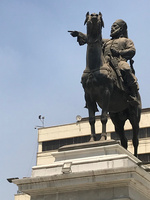
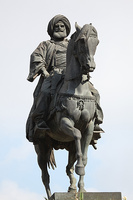
Isma‘il was possibly inspired by the equestrian statues that he saw in Paris, especially those commemorating Henry IV, Louis XIII, and Louis XIV that belonged to a tradition established by the Bourbon monarchy as early as the seventeenth century. Such statues, as June Hargrove has noted, were “icons of dynastic hierarchy” that immortalized “the omnipotent power of the throne.”[3] But he also may have admired the two grand equestrian statues by M. Louis Rochet (1813–78) at the La Bourdonnaye entrance of the Exposition that represented Don Pedro I, emperor of Brazil (unveiled 1862; Praça Tiradentes, Rio de Janeiro), and Charlemagne, king of the Franks and Holy Roman emperor (1867; plaster, Parvis de Notre-Dame, Paris). Whatever his immediate inspiration, it is clear that Isma‘il resolved to pioneer his family’s own tradition of royal equestrian statues as a means of glorifying Egypt’s ruling dynasty. That Isma‘il chose to commemorate his family instead of glorifying himself, unlike most European monarchs who were interested in elevating only themselves, may have been intended to define his own position in the dynastic chain of succession, as the historian Klaus Kreiser has suggested.[4] Although this may have been a factor, I believe that it was out of respect for his ancestry, just as his great-grandson King Fu‘ad (r. 1923–36) did later, when he elected to commemorate Isma‘il instead of himself.[5] Given that Muhammad ‘Ali was the founder of the dynasty and the one who put Egypt on the path toward modernization (in the military, educational, industrial, agricultural, and medical systems), obtained the right of hereditary rule over Egypt, and dreamt of building an empire,[6] and that it was his son Ibrahim, the military hero, who achieved major victories and seized territories from the Ottomans,[7] Isma‘il’s choice makes sense.
This article brings into focus a little-studied area of nineteenth-century Egyptian art, namely public royal statues.[8] It contributes to a recent trend in the study of artistic and cultural interactions between Europeans, Ottomans, and Egyptians, firmly grounded in social and political history, that defies or at least nuances previously held notions about the West’s desire to assume a position of power and dominance, and the East simply mimicking or responding to the West.[9] On the basis of in-depth archival research in Egypt related to the commission of the two statues, as well as period media sources—Egyptian as well as European—related to their reception, I intend to show that the khedive chose a typical Western symbol of power, the equestrian statue, and had it carefully adapted and modified to make his modern Egyptian dynasty’s independence visible to the European powers and to the Ottoman Empire, as well as to his urban elites. Indeed, documents from Egyptian National Archives, consisting mostly of letters between patrons, intermediaries, and artists, demonstrate the complex negotiations regarding the precise forms the statues were to take between Egypt’s ruler and his entourage, and the French artists, architects, and bureaucrats who were involved in carrying out the khedive’s commission.[10]
The portrayal of an independent and powerful dynasty was part of Isma‘il’s policy, as exemplified by his urban transformation and cultural projects,[11] and by Egypt’s representation on the world stage.[12] The royal statues combined both Western and Oriental proclivities. While Muhammad ‘Ali Pasha and Ibrahim Pasha were represented in their local costumes, and their horses adorned with their dynasty’s royal emblems,[13] their poses were influenced by French prototypes. To execute his family’s statues, Isma‘il turned to France—which was then considered artistically superior—and hired the leading sculptors of the period. At times, the khedive listened to the advice of the French sculptors and the committee established to oversee the commission, but he played an instrumental role himself in fashioning his family’s monuments—just as he was actively engaged in matters of national representation.[14] Simultaneously, the fine arts circle in France had its own interests: namely to uphold Paris’s position as the art capital of the world and, of course, to seek business opportunities in a country where artistic production—including painting, sculpture, and photography—was still usually in the hands of non-Muslim communities or Europeans (mostly the French).[15]
Between Paris and Cairo
Records show that a number of French sculptors eagerly sought the commission of the royal statues. In a letter to Isma‘il dated December 7, 1867, Firmin Rainbeaux—an aide-de-camp of Emperor Napoleon III (r. 1852–70) and an art collector—recommended Jean-Baptiste Carpeaux (1827–75). He wrote that when Carpeaux heard that Isma‘il intended to commission a French artist to execute an equestrian statue for his grandfather, he “implored me to solicit your favor to obtain this commission” and continued, “Carpeaux is one of our leading celebrities, who executed important works commissioned by the Emperor for the Tuileries and various public monuments.”[16] Carpeaux did not get the commission. Instead, it went to Jacquemart, who was highly recommended by Comte Alfred-Émilien de Nieuwerkerke (1811–92), superintendent of fine arts under Napoleon III.
Cordier, however, did not need an intermediary. He enjoyed an excellent relationship with the khedive, having executed his marble bust in 1866. Famous for his ethnographic types and polychrome statues, Cordier traveled to Algeria (1856), Greece (1858), and Egypt (1866 and 1868) with grants from the French government to reproduce diverse ethnic types in sculpture.[17] On his second trip to Egypt in 1868 (possibly February–June),[18] he endeavored to secure the commissions for Ibrahim Pasha’s equestrian statue and a fountain for the Azbakiyya gardens, entitled Egyptian Fountain, Personification of the White Nile, the Blue Nile, and the Nile in the Figures of a Nubian Woman, Abyssinian Woman, and Egyptian Peasant Woman.[19] The latter project was not realized, but Cordier obtained the commission for Ibrahim’s equestrian statue.
We have no sources that confirm the circumstances or the date of the commission for Ibrahim Pasha’s equestrian statue. We do know from Isma‘il’s undated letter addressed to his Armenian foreign minister, Nubar Pasha, that “those were my definitive specifications for the statue of my illustrious father, the execution of which has been entrusted to Mr. Cordier . . . nonetheless I would like the sketch for his work to be examined by a committee of the Academy of Fine Arts in Paris, as is the common practice among all governments that have their artworks executed in France.”[20] By August 1868, the special committee, comprising Superintendent of Fine Arts Comte de Nieuwerkerke; writers Théophile Gautier, Paul de Saint Victor, and Charles Edmond; artists Jean-Léon Gérôme and Charles Louis Müller; and civil engineer Jean-Antoine Cordier Bey, was formed and work on the statue had begun. The committee members visited Cordier’s atelier twice to review the equestrian statues and bas-reliefs, and suggested the following modifications, according to a letter by Cordier to Nubar Pasha:
The inscription in Arabic and Turkish characters on a bronze plate, letters embossed—the cornice of pedestal wider—base to be elevated a bit more . . . no changes to the bas-reliefs. In the equestrian statue the Committee has requested that the pose of the horse be modified; this pose, if you remember, Excellency, represented the moment when the rider urging on his mount stands tall to give an order. The Committee felt this movement is more appropriate for a colonel rather than a general legislator like the August father of His Highness, who preferred a quiet horse though the rider showed the same movement.[21]
Cordier heeded the advice. The statue portrayed Ibrahim Pasha in a Turkish army uniform, complete with a tarboosh (fez in Turkish), poised on his horse, decorated with the royal emblem of the crescent and five-pointed star, with all four hooves on the ground. His left outstretched arm pointed to further conquests, his right hand holding the reins (see fig. 1). Ibrahim’s depiction as a soldier is fitting. As the US diplomat and writer Edwin de Leon wrote in 1877, Ibrahim’s statue showed him as “every inch a soldier, and a born leader of men on the battlefield.”[22]
Although there are some similarities between the statue of Ibrahim and that of Louis XIV by Louis-Messidor-Lebon Petitot (1794–1862)—one of the statues Isma‘il might have seen—at Versailles (erected in 1836, fig. 3), a closer model of the horse and rider can be found in the statue of Napoleon I by Charles-Pierre-Victor Pajol (1812–91) at Montereau-Fault-Yonne (erected in 1867, fig. 4). Both Ibrahim and Napoleon I are depicted as the military leaders they were and both are seated on well-grounded horses, with their right arms outstretched. Bronze reliefs depicting their important battles decorate both pedestals. The reliefs on Ibrahim’s pedestal feature his battles against the Ottomans at Konya in December 1832 (The Battle of Konya; fig. 5) and at Acre in May 1832 (The Taking of Saint-Jean-d’Arc; fig. 6). Ultimately, however, the reliefs were not used because of strong objections from Istanbul. In September 1868, a Turkish newspaper described the statue with its battle scenes[23]—based on Cordier’s display of a half-scale plaster version of the statue and the clay model of one of the reliefs in his atelier.[24] The grand vizier, or prime minister, of the Ottoman Empire had this message for the khedive:
Telegraph the Khedive so that he orders the artist to stop the work, or change the subject, and ask his Highness to give me an answer on this matter, because even though Egypt would be independent, the Viceroy should not commit such an insult to his fellow believers.[25]
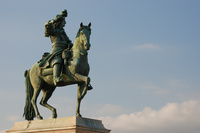
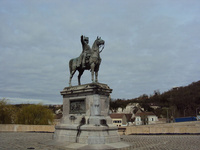


Mindful of balancing his relations with the Ottoman government, Isma‘il acquiesced, and the reliefs were not used (fig. 7). They would be installed only eighty years later, on the occasion of the centenary of Ibrahim Pasha’s death, on November 10, 1948. Although the reliefs have been attributed to Cordier’s grandson, Jules Cordier, who supposedly replicated them from a photograph,[26] they were, in fact, executed by the Egyptian sculptors Ahmad Osman (1907–70), and Mansour Farag (1910–2000)—possibly from photographs by Cordier’s grandson.[27] The Battle of Konya relief is also signed in Arabic: “After Cordier Ahmad Osman and Mansour Farag” (fig. 8).
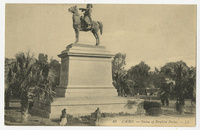
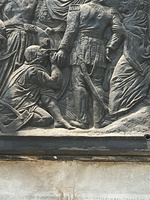
Nieuwerkerke—who was chosen to head the committee—wrote to Isma‘il on December 4, 1868, accepting “the honor of presiding over the committee charged to supervise . . . the execution of the monument your Highness has ordered for the memory of Ibrahim Pasha for two reasons. First, because I was happy to have the opportunity to please your highness; second, because the work is being given to a French artist and is the first to be erected on Egyptian soil, I will ensure it is in the best possible condition.”[28] In the same letter, he relayed the committee’s decision to bring in another artist to help Cordier—a decision that ruptured the sculptor’s relationship with Nieuwerkerke:[29]
The committee, which came before, after an initial examination of the project of Mr. Cordier, realized that this artist, who has proved his talent in numerous works he has produced, has never studied the horse and would experience unsurmountable difficulties in the execution of one destined to carry the glorious figure of Ibrahim Pasha.
The committee has therefore decided that a special artist should assist Mr. Cordier and it has chosen Mr. Jacquemart, who has a most glorious record of reproducing animals in art.
Knowing that Your Highness has the happy thought of adding four lions to the composition of the monument, allow me to recommend Mr. Jacquemart for their execution.
If, later on, Your Highness intends to erect a second equestrian statue to glorify another Egyptian ruler, I think he could make no better choice than the artist [Jacquemart] whom I have the honor to recommend to him.[30]
In addition to “advising and overseeing” Cordier’s horse,[31] Jacquemart was commissioned to create the equestrian statue of Muhammad ‘Ali. He was one of the most famous animaliers (animal sculptors) of the Second Empire (1852–70) and had a number of important monuments to his name, including that of Louis XII and Napoleon III, as well as the sphinxes—which served as fountain spouts—for the Fontaine de la Victoire (Fontaine du Palmier) fountain in the Place du Châtelet in Paris. The latter project, which Jacquemart executed in 1858, was, in fact, his first encounter with Egypt before he traveled to the country between 1860 and 1870. While he was already a renowned artist when he was entrusted with the commission, he also had the backing of the most influential man in the French art world, Comte de Nieuwerkerke. Jacquemart must have impressed Isma‘il, as he awarded him the commission of two other life-size statues. They represent two dignitaries in Muhammad ‘Ali’s service: the French Soliman Pasha al Faransawi (“Faransawi” meaning the Frenchman), alias Joseph-Anthelme Sève, who established Egypt’s modern, Europeanized army and training program and became a celebrated general (exhibited at the Paris Salon in 1874, now in front of the Military Museum, Cairo; fig. 9); and the Albanian Muhammad Lazoghli Bey, who was a trusted katkhoda, or deputy (exhibited at the Paris Salon in 1875, now in Lazoghli Square, Cairo; fig. 10).
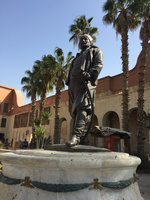
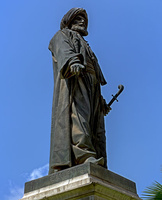
Documents in the Egyptian archives related to the Muhammad ‘Ali statue start with a letter from Nubar Pasha dated December 28, 1868:
I have the honor to receive the telegram in which our August Sovereign instructed me to coordinate with the Comte de Nieuwerkerke regarding the execution of the Grand Viceroy’s statue. I saw the Comte last night at Princess Mathilde’s. . . . The Comte proposed that M. Jacquemart execute the statue. M. Jacquemart has to submit his sketches and models to the same committee instituted to oversee the sculptures commissioned from Mr. Cordier, provided his Royal Highness has no objections against this committee as it has been formed. . . . But in any case, we should know beforehand 1) the dimensions of the space in Alexandria where the statue will be erected . . . 2) the costume the Viceroy should wear: Constantinopolitan-Nizam with the tarboosh or Mamluk with the turban? The base on which the statue will be placed, will there be bronze bas-reliefs, and if so what will they represent? All these questions completely depend on the wishes of our August Master.[32]
This letter not only reveals the crucial role Isma‘il had in creating the image of the dynasty, but it also provides insight into the artistic milieu in Paris and professional networks in which artists were circulating. Princess Mathilde Bonaparte, herself a painter and an exemplar of cultural sophistication during the Second Empire, held regular salons at her home that were frequently attended by leading literary and artistic figures, including Gustave Flaubert, Théophile Gautier, the Goncourt brothers, Jean-Baptiste Carpeaux, Ernest Hébert, Eugène-Emmanuel Amaury-Duval, and Nieuwerkerke—who was also one of her lovers.[33]
As head of the committee, Nieuwerkerke was also responsible for the financial aspects of the commission. All money transactions were made in the comte’s name.[34] On April 7, 1869, he wrote Isma‘il’s minister of foreign affairs to “relay to his royal highness my satisfaction with the price of two hundred thousand francs offered to Mr. Jacquemart for the equestrian statue of Muhammad ‘Ali,”[35] although earlier he had made a point of letting the khedive know that he thought Cordier’s fee was excessive.[36]
The final composition of Muhammad ‘Ali’s statue shows him dressed in Mamluk clothing with a turban and a gray beard, but with a strong, youthful physique and piercing gaze, in the act of guiding a calmly advancing horse (see fig. 2). It is interesting that Isma‘il chose the Mamluk costume, even though Muhammad ‘Ali had introduced clothing reforms in 1823—following the example of Sultan Mahmud II (r. 1808–39)—including the replacement of the Mamluk turban with the Turkish fez.[37] However, as Cadalvene and Brueuvery pointed out in L’Égypte et la Turquie, de 1829 à 1836 (Egypt and Turkey, from 1829 to 1836), although Muhammad ‘Ali Pasha imposed on his troops the Turkish costume of the Empire, he did not apply it to himself, and in the evenings he would wear the long clothing of the Mamluks with a large white turban on his head.[38]
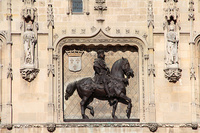
Muhammad ‘Ali’s horse, also decorated with the dynasty’s royal emblem, is in walking position with the right foreleg raised, following the popular prototype of many French equestrian statues like that of Henry IV. His pose, with one hand on his thigh and the other holding the reins, recalls that of Louis XII’s equestrian bas-relief at Compiègne, which was also executed by Jacquemart and shown at the Salon of 1869 (fig. 11).[39] It is not known whether the pose was suggested by Jacquemart, the committee, or even Isma‘il, although it may have been intended to underscore the connection with Louis XII, who was known during his reign as “Father of the People.” It is surprising, however, that a visual connection with Napoleon I was not made instead. In writing about Muhammad Ali’s statue, de Leon convincingly likened him to Napoleon I: “The equestrian statue of ‘Napoleon of Egypt’ [Muhammad ‘Ali] looks proudly down from the Grand Plaza of Alexandria, seeming to keep watch and ward over the city of his love: so the mighty shadows of its founder still seems to rule Egypt . . . and protect it.”[40] De Leon went on to aptly sum up the similarity between the two rulers: neither was born in the country they ruled and where they had established their dynasties, and both were soldiers and statesmen who dreamt of founding an empire and obtaining succession for their heirs.[41] Ironically, as de Leon remarked, while each ruler founded his empire, it was Muhammad ‘Ali’s dynasty that lasted much longer.[42] Isma‘il also must have known that his grandfather followed the example of Napoleon in exalting his image. Muhammad ‘Ali had a large number of portraits painted by European artists, as shown in Gaston Wiet’s book Mohammed Ali et les beaux-arts (Muhammad ‘Ali and the Fine Arts).[43] As Doris Behrens-Abouseif has pointed out, the viceroy “enjoyed this publicity . . . and gladly [posed] for painters and daguerreotype-photographers.”[44] In 2019, art critic and researcher Yasser Mongy wrote that the portraits of Muhammad ‘Ali, which were shown at the exhibition Features of an Era in Cairo “reflect [Muhammad ‘Ali’s] obsession with Napoleon” and that “he understood how Napoleon used art to propagate an image, and you can see the similarities in his pose” (fig. 12).[45]
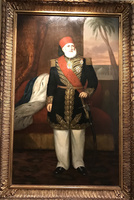
The pedestal for the statue of Muhammad ‘Ali was commissioned from Louis-Victor Louvet (1822–98), but he could not complete it because he was busy with the Panthéon projects. Instead, the committee nominated his former student, Ambroise Baudry (1838–1906),[46] and Isma‘il gave his blessing and requested that financial arrangements would ensure the work be well executed.[47] Baudry was paid twenty thousand francs.[48] The brother of the famous painter Paul-Jacques-Aimé Baudry (1828–86), Ambroise had the right contacts in France, which included the architect who created the Paris Opera, Charles Garnier, and the novelist and art critic Edmond About, whom Isma‘il had commissioned to write Le Fellah: Souvenirs d’Égypte (The Peasant: Memories of Egypt; 1869). In Egypt—where Baudry lived from 1871 to 1886 and became Khedive Isma‘il’s chief architect from 1875 to 1878—he built up networks with the French and local elite in the khedive’s entourage, such as the engineer Delort de Gléon and Nubar Pasha.[49] Baudry, no doubt, typifies those French artists, architects, and bureaucrats who crossed cultural borders and became mediators between Egypt and France. He transmitted Western modes of architecture that he had learned at the École des Beaux-Arts, while adopting Islamic styles. He became one of the earliest collectors of Islamic art and was among those who campaigned in the 1870s to preserve Cairo’s Islamic architecture and ornament, eventually leading to the establishment of the Comité de Conservation de l’Art Arabe (Committee for the conservation of Arab art) in 1881.[50]
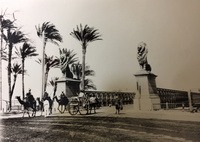
The initial design of the foot of the pedestal of Muhammad ‘Ali’s statue, featuring four lions on the four corners, was changed. A letter issued from the cabinet of the khedive addressed to Sherif Pasha, the minister of the interior, states that “Jacquemart thought that the four lions ordered for the pedestal will have a mediocre effect and, by enlarging them, they would be more appropriate to be placed at each side of the Qasr al-Nil Bridge” in Cairo (fig. 13).[51] Isma‘il agreed, and the lions were then enlarged from two to four meters and erected in 1873, two at each side of the bridge. The swing bridge, built in 1869–71 to link the eastern shore at Qasr al-Nil and the southern tip of the Gezira, was designed by the French engineer Linant de Bellefonds[52] and constructed by the French company Fives-Lille.[53]
Isma’il was eager to have the two statues finished at the same time and wanted the unveiling of the statue of Muhammad ‘Ali first in order to follow protocol by first honoring his grandfather and founder of the dynasty.[54] The statue was completed promptly. Gérôme and sculptor Eugène Guillaume (1822–1905) sent a letter to Sherif Pasha on July 3, 1872, praising Muhammad ‘Ali’s statue: “All the difficulties concerning the statue were overcome by Jacquemart in a masterful way. The beautiful effect this monument will have in Alexandria is assured: the work is worthy of his highness’s government and of the great man to whom Egypt wants to dedicate this powerful image and glorious commemoration.”[55]
Exhibiting the Statues in Paris
Before the journey to their final destination, the statues were displayed, together with other royal equestrian statues, to the French public. Cast by Thiébaut Frères, both bronze equestrian statues were exhibited to critical acclaim at the Paris Salon in May 1872 for one month. The official Salon catalogue listed Ibrahim Pasha’s sculpture under Cordier’s name without any mention of Jacquemart’s contribution.[56] It did not list Muhammad ‘Ali’s statue. L’Illustration, on the other hand, reported on July 2, 1872, that both were displayed outdoors at the Champs-Élysées. “In the square in the east near the restaurant, Ledoyen, an equestrian statue on a high pedestal, Mohammad [‘]Ali, by Mr. Alfred Jacquemart, destined to be placed in Alexandria; in the square to the west in front of the Diorama, another equestrian statue, even more colossal of Ibrahim Pasha, by Mr. Jules Cordier destined to be placed in Cairo. It is Paris that provides people of the old and new world with heroes and gods!”[57] The French, recovering from their crushing defeat at the hands of the Prussians in 1871, were certainly happy to celebrate their superiority in the arts. Writing about Soliman Pasha’s statue, which was shown later at the 1874 Salon, critic Jules-Antoine Castagnary wrote, “Egypt has commissioned M. Jacquemart to adorn one of its squares with the statue of S[oli]man Pasha . . . this enthusiasm within, this growing expansion abroad, this is the first consolation for our misfortunes [a reference to France’s losses in the Franco-Prussian War], and this is the real recovery that begins . . . France’s artistic superiority has been recognized: its moral supremacy resumes its course.” [58] Moreover, the satirical journal Le Grelot (The Bell) featured both statues of Ibrahim Pasha and Muhammad ‘Ali with the following caption: “It must be said, the presentation and lightness of Jacquemart’s horse captivated opinion, Cordier’s rigorous and well-planted horse was not without supporters, but it was not entirely lifelike. Jacquemart’s triumphed easily . . . But who knows what would have happened if Cordier’s horse had its wheels?” (fig. 14).[59]
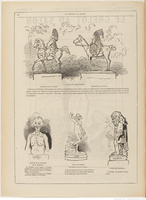
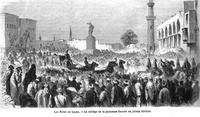
The Statues in Egypt
The statues arrived in Egypt on July 2, 1872.[60] There are no known sources reporting on the unveiling ceremony of Ibrahim Pasha’s statue. It appears, however, that his statue was first erected in Midan Azbak before its relocation in front of the Opera House, as illustrated in L’Illustration in January 1873 (fig. 15),[61] and Cahiers d’histoire égyptienne (Egyptian history papers) of 1948.[62] A replica of Ibrahim Pasha’s statue also stands at the entrance of the military museum at the citadel in Cairo.[63] A portrait of Ibrahim’s equestrian statue was hung in the Opera House.[64] As for Muhammad ‘Ali’s statue, it was unveiled on August 16, 1873, at the Place des Consuls, over a year after it was erected in the square.[65] Historian Georges Douin described the event as “a very simple ceremony that lasted for a couple of minutes. It was presided over by the governor of Alexandria and by an Egyptian general, no prince or minister attended . . . the grand majority of spectators consisted of Europeans who were there by chance. A cannon salute was fired by fort and infantry troops.”[66] The reason for this understated ceremony is unclear. What is even more striking is the absence of Isma‘il and his ministers, even though, as Douin noted, on August 14 the khedive had arrived in Alexandria, where he stayed for three days, and the city was lit up in celebration upon his return.[67]
The statues were strategically placed in the European and most modern squares of the country’s metropolises, thereby serving as a constant reminder of the dynasty’s contribution to urban modernization. Muhammad ‘Ali had revived his beloved city of Alexandria as an important commercial port with the modern infrastructure to become the second capital of the country. The Place des Consuls—the hub of European consulates, merchants, and financiers—was redesigned in the 1840s by the Italian engineer Francesco Mancini, under Ibrahim’s supervision.[68] Under Isma‘il, the square was extended with the addition of a French-style garden, hotels, a church, and a synagogue. John Murray’s handbook of 1875 vividly describes the square as “the European centre of Alexandria. In it are situated the principal hotels, shops, bankers’ and merchants’ offices. At the N. E. corner is the English church, and on the same side is the French consulate. . . . Recent improvements have made the interior of the square a very pleasant promenade, shaded by trees and well provided with seats. At each side is a large fountain; and in the centre a statue of the great Mohammad [‘]Ali.”[69] A second equestrian statue of Muhammad ‘Ali was later erected by King Fu‘ad in his native town of Kavala in Macedonia (now in Greece).[70]
Azbakiyya—the area in Cairo of the rich and famous since its founding in the fifteenth century—was the nexus of the city’s transformation from its medieval past to a modern, European-style square.[71] The historic relevance of the square must have resonated with Isma‘il: Azbakiyya was the headquarters of Napoleon Bonaparte during the French occupation; it was Muhammad ‘Ali’s headquarters where he received the firman designating him as governor of Egypt, and where he was officially appointed in the presence of Egypt’s ‘ulema (Muslim scholars) and officials.[72] From that time onward, many public and dynastic celebrations were held in that square throughout the century. Azbakiyya was also the site of major renovations between 1867 and 1869, becoming one of the most famous squares in the world, comparable to Paris’s Champs de Mars, the Place de la Concorde, and the Parc Monceau—after which it was modeled.[73]
The Egyptian Perception
The attitude toward the visual arts in Egypt—as in other Muslim lands—during the nineteenth century was somewhat ambiguous. Technically, figural art was prohibited in Ottoman and Arab lands. The four Sunni schools of law generally forbade the visual representation of a living being, until Egypt’s Grand Mufti (a legal authority responsible for interpreting Islamic Law or Shari‘a) Muhammad ‘Abduh issued a fatwa (religious decree) in 1904, legalizing figural images and emphasizing their educational value.[74] However, even prior to the new decree, and despite the religious orthodox ban on figural visual representation, the practice of portraiture, per se, was not uncommon. Ottoman sultans, such as Mahmud II, commissioned large-scale painted portraits to send to other rulers; Mahmud II began the tradition of displaying his portraits in government offices, military barracks, and war ships, a custom that is still practiced today in government buildings and other public spaces throughout the Middle East. Mahmud II’s initiatives, however, eventually led to an uprising.[75] In Egypt, as already noted, Muhammad ‘Ali also had a large number of portraits, as did Isma‘il.[76] The latter, however, was the first modern ruler in the Ottoman Empire to initiate figural sculpture to be displayed in public spaces. So did their intended symbolism reach beyond the urban elites?[77] In my opinion, Isma‘il was not targeting ordinary Egyptians, as they prized colloquial poetry, songs, and performances over visual art.
So, what was the reason for the delay and modest inauguration ceremony for Muhammad ‘Ali’s statue? Was there even a ceremony for the unveiling of Ibrahim Pasha’s statue? Isma‘il undoubtedly would have wanted to stage spectacular events and use them as propaganda tools similar to the opening of the Suez Canal in 1869. One possibility is that there could have been strong objections by religious authorities and public opinion to the erection of the statues similar to those that occurred in Turkey. One also has to look at what happened in 1882—three years after Isma‘il’s deposition[78]—when the statues became a source of controversy during the ‘Urabi revolt, which protested the Ottoman monopoly of power and European intervention in economic affairs. At that time, Ahmad ‘Urabi used the longstanding religious ban of figural art to command the destruction of the statues in order to appeal to his supporters with Islamic fervor.[79] He asked the Grand Mufti Muhammad al-‘Abbas al-Mahdi to issue a fatwa calling for the statues’ destruction, according to Islamic law.[80] The mufti’s fatwa of August 31, 1882, reiterated the Islamic position toward figural representation, prompting Sheikh ‘Ullaish to incite protestors to remove the statues, including the lions of Qasr al-Nil bridge and that of Ibrahim Pasha at Azbakiyya.[81] The statues were then taken to the Egyptian Museum at Bulaq and, after the revolt was suppressed, they were returned to their locations.[82] They remain in place today, even after the 1952 military revolution that ended a century and a half of dynastic rule by Muhammad ‘Ali’s family.
Conclusion
This article has examined the production process of two royal monuments in late nineteenth-century Egypt from the dual point of view of their Egyptian patrons and the French artists who executed them. Based on material in the Egyptian National Archives and French published sources, it offers an insight into the complex dynamic between Egyptian and French artistic encounters at the time. A number of conclusions can be drawn from this study. First, it shows the agency of Egypt’s ruler in defining symbolic forms that project a powerful and independent dynastic image to the European powers and to the Ottoman Empire, as well as to his urban elites. To execute the equestrian statues, Isma‘il used a typical Western power symbol, the equestrian statue, and hired two of the most famous French sculptors, working under the supervision of a committee composed of members of the French Academy. But, while his grandfather’s and father’s poses were influenced by French prototypes, reflecting a Western orientation, their clothing, emblems, and the reliefs on Ibrahim Pasha’s pedestal suggest a potent and sovereign Egyptian dynasty. This dual orientation projected pride in the dynasty’s origins as well as parity with Western ruling dynasties. Secondly, the French artists discussed above were not concerned with imperialism. While some may have paid lip service to the idea of upholding France’s leadership in the arts, they were primarily motivated by financial interests and preoccupied with building their careers. Cairo was a lucrative market, and to have a foothold artists had to have a strong network across borders.
Acknowledgments
This article is based on a chapter of my PhD dissertation, “Egyptian-French Encounters: Art and National Identity, 1867–1928,” which is part of a much larger project that explores the complex dynamic of Egyptian-French encounters between 1867 and 1928, focusing on how the Egyptians—ruling elite and nationalists—used and adapted European traditions for visual representation to serve their own ends. I would like to thank Susan Sidlauskas for her guidance and feedback. Special thanks to Petra ten-Doesschate Chu for her mentorship, insightful suggestions, and edits. I am also grateful to the anonymous reviewers for their valuable comments, and to Cara Jordan and Isabel Taube from Nineteenth-Century Art Worldwide. In addition, I am thankful for the support and input of the Dahesh Museum of Art’s Board of Trustees, especially Amira Zahid, and my colleagues, J. David Farmer and Stephen R. Edidin.
Notes
All translations are by the author unless indicated otherwise.
Epigraph: “Nous sommes tous convaincus que le bonheur de l’Égypte dépend de sa séparation définitive d’avec la Turquie . . . c’est nous qui immortaliserons notre nom.” Letter from Isma‘il to Nubar, April 8, 1867; quoted in Georges Douin, Histoire du règne du Khédive Ismail, Tome Deuxième, L’Apogée 1867–1873, vol. 2 (Rome: Istituto Poligrafico dello Stato per la Reale Società di Geografia d’Egitto, 1934), title page.
[1] On Isma‘il and his reign, see Edwin de Leon, The Khedive’s Egypt; Or, The Old House of Bondage under New Masters (London: Sampson Low, Marston, Searle & Rivington, 1877); Georges Douin, Histoire du règne du Khédive Ismaïl, 3 vols. (Rome: Istituto Poligrafico dello Stato per la Reale Società di Geografia d’Egitto, 1933–38); Angelo Sammarco, Histoire de l’Égypte moderne depuis Mohammed Ali jusqu’à l’occupation britannique, 1801–1882 d’après les documents originaux égyptiens et étranger, 3 vols. (Cairo: Impr. de L’Institut Français d’Archéologie Orientale, 1937); among others. On May 27, 1866, Isma‘il obtained the firman (decree) changing succession in Egypt to one of primogeniture. Georges Douin, Histoire du règne du Khédive Ismail: Tome premier, les premières années du règne 1863–1867, vol. 1 (Rome: Istituto Poligrafico dello Stato per la Reale Società di Geografia d’Egitto, 1933), 218–20.
[2] A firman issued on June 8, 1867, granted Isma‘il the title of khedive—a Persian word meaning king or lord—and with it the power to conclude commercial and financial treaties and initiate laws and regulations for the government of Egypt. Douin, Histoire du règne du Khédive Ismail, 1:442–43.
[3] June Ellen Hargrove, The Statues of Paris: An Open-Air Pantheon (New York: Vendome Press, 1989), 12.
[4] Klaus Kreiser, “Public Monuments in Turkey and Egypt,” Muqarnas 14 (1997): 106.
[5] The Italian community in Egypt wanted to erect a monument in Alexandria of King Fu‘ad in honor of his visit to Italy in 1927, but he requested it to be that of Khedive Isma‘il. The al-Ahram newspaper explained that the king “had a strong tendency to exalt his great grandfather and show his feats as well.” Isma‘il’s statue by Italian sculptor Pietro Canonica (1869–1959) was completed in 1935 and unveiled in 1938 (now in Khedive Isma‘il Square, Alexandria). See Yasser Mongy, “Features of an Era Are Refected in Its Figures,” in Features of an Era, exh. cat. (Cairo: n.p., 2019), http://www.fineart.gov.eg/.
[6] On Muhammad ‘Ali Pasha, see Georges Douin, Mohamed Aly Pasha du Caire: Correspondance des consuls de France en Egypte (Cairo: Impr. de l’Institut Français d’Archéologie Orientale du Caire pour la Société Royale de Géographie d’Egypte, 1926); Afaf Lutfi al-Sayyid-Marsot, Egypt in the Reign of Muhammad Ali (New York: Cambridge University Press, 1984); and Khaled Fahmy, All the Pasha’s Men: Mehmed Ali, His Army, and the Making of New Egypt (New York: Cambridge University Press, 1997); among others.
[7] For Ibrahim’s major victories, see Hassan Ahmed Ibrahim, “The Egyptian Empire, 1805–1885,” in The Cambridge History of Egypt, ed. M. W. Daly, vol. 2 (Cambridge, UK: Cambridge University Press, 1998), 198–216.
[8] Klaus Kreiser offers a brief scholarly account of the statues commissioned by Isma‘il in “Public Monuments in Turkey and Egypt,” 104–17; and Lesley Lababidi surveys the statues in Cairo’s Street Stories: Exploring the City’s Statues, Squares, Bridges, Gardens, and Sidewalk Cafés (Cairo: American University in Cairo Press, 2008).
[9] Recent studies with a focus on historiography include Ahmet Ersoy, Architecture and the Late Ottoman Historical Imaginary: Reconfiguring the Architectural Past in a Modernizing Empire (Burlington, VT: Ashgate, 2015); Mary Roberts, Istanbul Exchanges: Ottomans, Orientalists, and Nineteenth Century Visual Culture (Berkley: University of California Press, 2015); and Adam Mestyan, Arab Patriotism—The Ideology and Culture of Power in Late Ottoman Egypt (Princeton, NJ: Princeton University Press, 2017).
[10] Letters from the Egyptian National Archives, Dar al-Watha’iq al- Qawmiyya in Cairo (hereinafter, DWQ), are in French and typewritten; some do not have dates, addressee names or senders. Recently, the archival system in DWQ was digitalized and now differs from the earlier archival classification. For example, the letters cited in the old archival system from Isma‘il’s private cabinet from a file entitled “Monuments” are now included in the new electronic unit “Usrat Muhammad ‘Ali” (Muhammad ‘Ali’s Family). For information on the archival series, see Helen Anne B Rivlin, The Dār al-Wathāʼiq in ʻĀbdīn Palace at Cairo as a Source for the Study of the Modernization of Egypt in the Nineteenth Century (Leiden, Netherlands: Brill, 1970); F. Robert. Hunter, “The Cairo Archives for the Study of Elites in Modern Egypt,” International Journal of Middle East Studies 4, no. 4 (1973): 476–88.
[11] See Adam Mestyan, “Power and Music in Cairo: Azbakiyya,” Urban History 40, no. 4 (2013): 681–704; and “The European Aesthetics of Khedivial Power,” in Arab Patriotism, 84–119.
[12] See Alia Nour, “Egyptian-French Cultural Encounters at the Paris Exposition Universelle of 1867,” MDCCC 6 (2017): 35–49, http://edizionicafoscari.unive.it/; and “Egyptian-French Cultural Encounters at the Opening of the Suez Canal in 1869,” in Making Waves: Crosscurrents in the Study of Nineteenth-Century Art, ed. Laurinda S. Dixon and Gabriel P. Weisberg (Turnhout, Belgium: Brepols Publishers, 2019), 183–93.
[13] Muhammad ‘Ali used the Ottoman red flag with crescent and star, but he made a slight variation, using a five-pointed star instead of the Ottoman six-pointed one.
[14] Nour, “Egyptian-French Cultural Encounters at the Paris Exposition Universelle,” and “Egyptian-French Cultural Encounters at the Opening of the Suez Canal.” See also, Mercedes Volait, “Égypte représentée ou Égypte en représentation? La Participation égyptienne aux expositions universelles de Paris (1867) et de Vienne (1873),” in Voyager d’Egypte vers l’Europe et inversement: Parcours croisés (1830–1950), ed. Randa Sabry (Paris: Classiques Garnier, 2019), https://hal.archives-ouvertes.fr/.
[15] Because of the general Islamic prohibition against the depiction of figural art, Egypt opened its School of Fine Arts only in 1908, four years after the Egyptian theologian Muhammad ‘Abduh (1849–1905) proclaimed a religious decree legalizing figural imagery. See note 74.
[16] “M’a prié de solliciter auprès d’Elle, la faveur d’obtenir la commande de cette œuvre. Mr. Carpeaux est une de nos premières célébrités, l’auteur de travaux importants commandés par l’Empereur pour le Palais des Tuileries; et par Mr. Haussmann pour l’Opéra et divers monuments publics.” Letter from Firmin Rainbeaux to Khedive Isma‘il, December 7, 1867, Magmou‘at Mukatabaat Khasa Bi Inshaa’ Tamatheel Li Muhammad Ali and Ibrahim Pasha (Documents Relating to the Statues of Muhammad ‘Ali and Ibrahim Pasha), 5013–004151, DWQ.
[17] See Laure de Margerie et al., Facing the Other: Charles Cordier (1827–1905), Ethnographic Sculptor, exh. cat. (New York: Harry N. Abrams, 2004).
[18] The French government granted Cordier a grant of 30 percent discount on travel. De Margerie et al., Facing the Other, 136, 141n48.
[19] A full-scale plaster model of the unrealized fountain (location unknown) was exhibited in the 1869 Paris Salon, no. 3326. According to Rioux Maillou, it was still in Cordier’s studio in 1875. Jeannine Durand-Révillon and Laure de Margerie, “Catalogue Raisonné,” in Facing the Other, 170, no. 237.
[20] “Qu’elles étaient mes résolutions définitives à l’égard de la statue de Mon illustre père dont l’exécution a été confiée à Mr. Cordier . . . je désire néanmoins que le projet de son œuvre soit soumis à l’examen d’une commission de l’Académie des Beaux-Arts de Paris, tel étant l’usage admis par tous gouvernements qui font exécuter des œuvres d’art en France.” Although the letter is unsigned, the content indicates it is from Isma‘il. It is stamped non envoyé (unsent), 5013–004151, Magmou‘at Mukatabaat, DWQ.
[21] “L’inscription en caractère arabes et turcs sur une plaque de bronze, les lettres en relief—la corniche du piédestal plus ample—un peu plus d’élévation à la base . . . pas de changement dans les bas-reliefs. Dans la statue équestre la Commission a demandé que la pose du cheval soit modifiée, cette pose si vous vous le rappelez, Excellence, représentait le moment où le cavalier pressant sa monture va s’élancer donnant un ordre. La commission a pensé que ce mouvement convenait plutôt à un colonel qu’à un général législateur comme était l’Auguste père de Son Altesse, elle a préféré un cheval tranquille le cavalier ayant pourtant le même mouvement.” Letter from Charles Cordier to Nubar Pasha, August 3, 1868, 5013–004151, Magmou‘at Mukatabaat, DWQ.
[22] De Leon, The Khedive’s Egypt, 76.
[23] Rûznâme-i Cerîde-i Havâdis (Daily Newspaper of Events) no. 998, September 29, 1868 (II CII 1285); cited in Kreiser, “Public Monuments in Turkey and Egypt,” 107, 116n30.
[24] Durand-Révillon and de Margerie, “Catalogue Raisonné,” 177, no. 284.
[25] “Télégraphiez au Khédive qu’il donne l’ordre à l’artiste de suspendre les travaux, qu’il choisisse un autre sujet et priez son Altesse de me donner la réponse de cette affaire car quand bien même l’Égypte serait indépendante le Vice-roi ne devrait pas faire, une telle insulte à son coreligionnaire a ajouté le Grand Vizier.” Letter without names of the addressee, sender, May 12 [year unknown], 5013–004151, Magmou‘at Mukatabaat, DWQ.
[26] Lababidi, Cairo’s Street Stories, 58.
[27] “The Story of Ibrahim Pasha’s Statue,” Al Hilal (Cairo), November 11, 1948; cited in Modern Egypt digital project in Bibliotheca Alexandrina: http://modernegypt.bibalex.org/. The relief is also cited in Ahmad Osman’s biography: Sayed Hamid Al-Sadr, Al-mathal Ahmad Osman: hayatu wa ‘amalu (Cairo: General Egyptian Book Organization, 1985), 14. The Battle of Konya is illustrated on page 49.
[28] “[l]’honneur de présider la commission chargée de surveiller . . . l’exécution du monument que votre Altesse fait élever à la mémoire d’Ibrahim Pacha pour deux raisons. La première, parce que j’étais heureux de saisir une occasion d’être agréable à Votre Altesse ; la seconde, parce que ce travail étant confié à un artiste français et cette statue étant la première élevée sur le territoire égyptien, je tenais à ce qu’il le fut dans les meilleures conditions possibles.” Letter from Nieuwerkerke to Isma‘il, December 4, 1868, 5013–004151, Magmou‘at Mukatabaat, DWQ.
[29] De Margerie et al., Facing the Other, 66.
[30] “La commission, qui a précède, après un premier examen du projet de Monsieur Cordier a reconnu que cet artiste qui a donné des preuves de talent dans plusieurs œuvres dont il est l’auteur, n’ayant jamais étudié le cheval, éprouverait d’insurmontables difficultés dans l’exécution de celui qui se destiné à porter la glorieuse figure d’Ibrahim Pacha. La commission a donc décidé qu’un artiste spécial serait adjoint à Mr. Cordier et elle a choisi Monsieur Jacquemart, qui a fait ses preuves de la façon la plus glorieuse dans l’art de reproduire les animaux. Sachant que Votre Altesse a l’heureuse pensée de faire entrer quatre figures de lions dans la composition du monument, je me permets de lui recommander Monsieur Jacquemart pour leur exécution. Si, plus tard, Votre Altesse avait l’intention d’élever une seconde statue équestre à la gloire d’un autre Souverain de l’Égypte, je crois qui [illegible] ne pourrait faire un meilleur choix que celui de l’artiste que j’ai l’honneur de lui recommander.” Letter from Nieuwerkerke to Isma‘il, December 4, 1868, 5013–004151, Magmou‘at Mukatabaat, DWQ.
[31] De Margerie et al., Facing the Other, 137.
[32] “J’ai l’honneur de recevoir le télégramme par lequel Notre Auguste Souverain m’ordonnait de m’entendre avec Mr. le Comte de Nieuwerkerke pour l’exécution de la statue du Grand Vice-Roi. J’ai vu le Comte hier soir chez la Princess Mathilde . . . Le Comte propose Mr. Jacquemart pour l’exécution de cette statue. Mr. Jacquemart devrait présenter ses projets et ses maquettes à la commission qui été institué pour juger les statues confiées à Mr. Cordier, au cas où son Altesse n’aurait aucune objection contre cette commission comme elle a été composée . . . Mais en tout cas, il faudrait connaître au préalable 1e) les dimensions de la place d’Alexandrie où la Statue doit être placée . . . 2e) le costume que doit porter le Grand Vice-Roi? Est-ce le costume constantinopolitain—le Nizam avec tarbouche, ou le mamelouk avec turban? La base sur laquelle la statue sera placée, aura-t-elle des bas-reliefs et si oui, que doivent-ils représenter? Toutes ces questions dépendent complètement du désir de Notre Auguste Maitre.” Letter from Nubar Pasha to Monsieur le Bey [possibly Eram Bey Secretary and Interpreter of Khedive Isma‘il (also Nubar’s brother-in-law)], December 28, 1868, 5013–004151, Magmou‘at Mukatabaat, DWQ.
[33] For information on Princess Mathilde, see Marguerite Castillon du Perron, La Princesse Mathilde (Paris: Amiot-Dumont, 1953).
[34] The holdings of the Egyptian archives include two money orders with down payments for the statues: one in the amount of 16,000 liras for the execution of Ibrahim Pasha’s statue; and the other in the amount of 8,000 pounds for Muhammad ‘Ali’s statue. “Abhath (Research),” box 140, no. 2, Funun Gamila (Fine Arts), DWQ.
[35] “Je vous prie de témoigner à Son Altesse la satisfaction que me fait éprouver la commande, au prix de deux cent mille francs, faite à Monsieur Jacquemart de la statue équestre de Méhémet-Ali.” According to Wiet, King Farouk authorized his private secretary to provide him with the documents related to this commission. I was unable to find this letter in the archives in Cairo. Gaston Wiet, Mohammed Ali et les beaux-arts (Cairo: Société Royale d’Études Historiques, 1950), 404.
[36] In his letter of December 28, 1868, to Monsieur le Bey [possibly Eram Bey], Nubar Pasha mentioned that Comte de Nieuwerkerke left the fee amount to be determined by Isma‘il, but wanted him to know that it should not be as liberal as that of Cordier. 5013–004151, Magmou‘at Mukatabaat, DWQ.
[37] Doris Behrens-Abouseif, “The Visual Transformation of Egypt during the Reign of Muhammad ‘Ali,” in Islamic Art in the 19th Century: Tradition, Innovation, and Eclecticism, ed. Doris Behrens-Abouseif and Stephen Vernoit (Leiden, Netherlands: Brill, 2006), 113.
[38] Edmond de Cadalvène and J. de Breuvery, L’Égypte et la Turquie, de 1829 à 1836 (Paris: A. Bertrand, 1836), 207; cited in Wiet, Mohammmad Ali et les Beaux-Arts, 295. For costume in nineteenth-century Egypt, see Edward William Lane, An Account of the Manners and Customs of the Modern Egyptians (1836; repr., London: East West Publications, 1981), 35–59.
[39] “No. 3511-Louix XII; statue équestre, bas-relief. Pour l’Hotel de Ville de Compiègne. (M. de la maison de l’Empereur et des Beaux-Arts),” Salon des artistes français, Explication des ouvrages de peinture et dessins, sculpture, architecture et gravure des artistes vivants (Paris, 1869), 492.
[40] De Leon, The Khedive’s Egypt, 64.
[41] De Leon, The Khedive’s Egypt, 64.
[42] De Leon, The Khedive’s Egypt, 65.
[43] Wiet, Mohammed Ali et les beaux-arts.
[44] Behrens-Abouseif, “The Visual Transformation of Egypt,” 113.
[45] See exhibition review, “Cairo exhibit takes nostalgic look at arts, culture during monarchy,” Al-Monitor (Washington, DC), February 19, 2019, https://www.al-monitor.com/.
[46] Marie-Crosnier-Leconte and Mercedes Volait, L’Égypte d’un architecte: Ambroise Baudry, 1838–1906 (Paris: Somogy Editions d’Art, 1998), 60.
[47] Typewritten and unsigned letter to Sherif Pasha [original not in file], n.d., 5013–004151, Magmou‘at Mukatabaat, DWQ.
[48] The information is from Baudry’s account books; quoted in Crosnier-Leconte and Volait, L’Égypte d’un architecte, 60, 104n28.
[49] Crosnier-Leconte and Volait, L’Égypte d’un architecte, 59.
[50] For a concise history of the Comité, see Donald Malcolm Reid, “Cultural Imperialism and Nationalism: The Struggle to Define and Control the Heritage of Arab Art in Egypt,” International Journal of Middle East Studies 24, no. 1 (February 1992): 57–76.
[51] “Mr. Jacquemart, y est-il écrit, pense que les quatre lions qui lui ont été commandés pour ce piédestal y seraient d’un médiocre effet et figureraient beaucoup mieux, en les grossissant, aux deux extrémités du pont Kasr el-Nil.” Letter from Khedive Isma‘il’s cabinet to Sherif Pasha, April 7, 1871; quoted in Wiet, Mohammmad Ali et les Beaux-Arts, 404.
[52] Linant de Bellefonds arrived in Egypt in 1817 and he lived there for the next sixty-five years, working on irrigation projects. From 1831 to 1825, he became chief engineer of public works in Upper Egypt, then of all Egypt, and, in 1869, minister of public works and advisor to Khedive Isma‘il. See “Louis Maurice Adolphe Linant de Bellefonds (1799–1883),” La Bibliothèque Nationale de France, accessed July 29, 2021, https://data.bnf.fr/.
[53] When the bridge opened, it was unofficially referred to Gezira Bridge. However, when the bridge was replaced in 1931, it was renamed Khedive Isma‘il Bridge, and then Qasr al-Nil Bridge (the Palace of the Nile in Arabic) after the revolution in 1952.
[54] Letter from Khedive Isma‘il to Nubar Pasha, undated and stamped “non envoyé,” 5013–004151, Magmou‘at Mukatabaat, DWQ.
[55] “Toutes les difficultés que présente la statuaire équestre ont été vaincues par Mr. Jacquemart et il l’a fait en maître. Le bel effet que doit produire le monument d’Alexandrie est assuré: l’œuvre sera digne du Gouvernement de Son Altesse et digne du grand homme dont l’Égypte a voulu consacrer la puissante image et le glorieux souvenir.” Wiet, Mohammmad Ali et les Beaux-Arts, 404–5.
[56] “No. 1615—Ibrahim Pacha, vice-roi d’Égypte: statue équestre, bronze. Les bas-reliefs du piédestal représentant: l’un, la prise d’Acre: l’autre, la bataille de Konieh.” Salon des artistes français, Explication des ouvrages de peinture et dessins, sculpture, architecture et gravure des artistes vivants exposé au palais des Champs-Elysées le 1er mai 1872 (Paris: Impr. des Sciences et Arts, 1872), 247.
[57] “Dans le square de l’Est, près du restaurant Ledoyen, une statue équestre sur un haut piédestal, le Méhémet-Ali, de M. Alfred Jacquemart, destinée à une place d’Alexandrie; dans le square d’Ouest, devant le Diorama, une autre statue équestre, plus colossale encore, Ibrahim Pacha, de M. Jules Cordier, destinée à une place au Caire. C’est Paris qui fournit aux peuples du vieux et nouveau monde des héros et des dieux!” “Salon de 1872,” L’Illustration (Paris), July 6, 1872.
[58] “L’Égypte a demandé à M. Jacquemart, pour orner l’une des places du Caire, la Statue de Suleyman-Pacha . . . Cette ardeur d’émulation au-dedans, cette expansion grandissante au dehors, c’est la première consolation de nos malheurs, c’est le véritable relèvement qui commence. La supériorité artistique de la France était constatée: sa suprématie morale reprend son cours.” Jules-Antoine Castagnary, Salons . . . Tome II. 1872–1879 (Paris: Bibliothèque Charpentier, 1892), 134. On the Franco-Prussian War, see Michael Howard, The Franco-Prussian War: The German Invasion of France, 1870–1871, 2nd ed. (London: Routledge, 2006).
[59] “Il faut le dire, les performances du cheval de Jacquemart et sa légèreté avaient captivé l’opinion. Le cheval de Cordier, rigoureux, bien planté ne manquait pas de partisans, mais il n’était pas complètement dans la forme. Le cheval de Jacquemart a triomphé et est arrivé facilement premier de plusieurs longueurs. Mais qui sait ce qui serait arrivé si le cheval de Cordier avait ses roulettes?” Le Grelot au Salon: le Salon de 1872 / dépeint et dessiné par Bertall (Paris, 1872), 26.
[60] The date of July 2 was given by Wiet in his discussion of Muhammad ‘Ali’s statue. Wiet, Mohammmad Ali et les Beaux-Arts, 405.
[61] “Celebrations of Cairo, the Procession of the Princess and Crown Prince,” L’Illustration (Paris), February 22, 1873, 128. That year witnessed the lavish wedding celebrations of four of Isma‘il’s children, those of hereditary prince Tawfik, Prince Hussein, Prince Hassan, and Princess Fatimah.
[62] Jacques Tagher, “Ibrahim Pacha, promoteur de l’idée panarabe moderne,” Cahiers d’histoire égyptienne (Cairo: Au Bouquiniste Oriental, 1948). There is no text on the statue, but a picture of it is illustrated between page 56 and 57. I could not find any records on the relocation of Ibrahim Pasha’s statue or on the unveiling ceremony.
[63] According to Mercedes Volait, “around 1983, this over-moulding was made during the creation of the outdoor Sculpture Museum and the renovation of the Military Museum in the Citadel.” Durand-Révillon and de Margerie, “Catalogue Raisonné,” 177, no. 288.
[64] For an image of the painting inside the Opera, see Mestyan, Arab Patriotism, 114.
[65] The initial date for the unveiling ceremony of December 19, 1872, was cancelled for unknown reasons. Douin, Histoire du règne de Khédive Isma‘il, 2:740–41.
[66] “La cérémonie fut très simple et ne dura que quelques minutes. Elle fut présidée par le gouverneur d’Alexandrie et par un général égyptien; aucun prince, aucun ministre n’y assista. Personne ne se doutait d’ailleurs dans la ville, une heure auparavant, que cette inauguration dût avoir lieu. La grande majorité des spectateurs était composée d’Européens que le hasard avait conduits sur les lieux. Un salut à coups de canon fut tiré par un fort et des troupes d’infanterie.” Douin, Histoire du règne de Khédive Isma‘il, 2:740–41.
[67] Douin, Histoire du règne de Khédive Isma‘il, 2:740.
[68] There is little information about Mancini. He came to Egypt in 1820 and founded the institution of the Commission of Ornament in Alexandria. See Cristina Pallini, “Italian Architects and Modern Egypt,” in Studies in Architecture, History and Culture—Papers by the 2003–2004 AKPIA@MIT Visiting Fellows (Cambridge, MA: The Agha Khan Program for Islamic Architecture at the Massachusetts Institute of Technology, 2004), 39–50, http://web.mit.edu/.
[69] John Murray, A Handbook for Travellers in Egypt: Including Descriptions of the Course of the Nile through Egypt and Nubia, Alexandria, Cairo, the Pyramids and Thebes, the Suez Canal, the Peninsula of Mount Sinai, the Oases, the F[a]yoom, Etc., 5th ed. (London: J. Murray, 1875), 93.
[70] Kreiser, “Public Monuments in Turkey and Egypt,” 108, 116n38.
[71] For the transformation of Azbakiyya Square from the Mamluk period to Isma‘il’s reign, see Doris Behrens-Abouseif, Azbakiyya and Its Environs: From Azbak to Ismail 1476–1879 (Cairo: Institut Français d’Archéologie Orientale, 1985); and Mestyan, “Power and Music in Cairo.”
[72] Behrens-Abouseif, Azbakiyya and Its Environs, 82.
[73] Behrens-Abouseif, Azbakiyya and Its Environs, 96.
[74] Journalist, theologian, jurist, and Egypt’s grand mufti from 1899 to 1905, Muhammad ‘Abduh, like his mentor al-Afghani, was considered an architect of Islamic modernism. For more on ‘Abduh’s biography and his fatwa, see Dina Ramadan, “The Aesthetics of the Modern: Producing Artists, Cultivating Collectors, and Imagining Audiences in Egypt 1908–1958” (PhD diss., Columbia University, 2013), 15–63; and Stephen Vernoit, “The Visual Arts in Nineteenth-Century Muslim Thought,” in Islamic Art in the 19th Century, 19–35.
[75] Vernoit notes that these practices by Mahmud II were questioned by religious authorities and eventually led to an uprising. The sultan, however, insisted on transporting his portraits with a lot of fanfare, accompanied by military parades, with gun salvoes, music, and fireworks. Vernoit, “The Visual Arts in Nineteenth-Century Muslim Thought,” 23–24.
[76] Mestyan, Arab Patriotism, 113–14.
[77] In Egypt, at the time, art (whether painting or sculpture) was a privilege of the wealthy urban elite, foreigners, and later educated Egyptians. Visual art steadily gained favor from the early twentieth century after the establishment of the School of Fine Arts—modeled after the École des Beaux-Arts—in Cairo in 1908.
[78] Following the enormous debts that Isma‘il accrued and the establishment of the Dual Control by Britain and France, he abdicated in favor of his son Tawfik (r. 1879–92).
[79] ‘Urabi, an Egyptian nationalist and officer in the Egyptian army led the revolt against Anglo-French financial and political influence, and authority of Khedive Tawfiq. See Alexander Schölch, Egypt for the Egyptians! The Socio-Political Crisis in Egypt, 1878–1882 (London: Ithaca Press, 1981).
[80] Rudolph Peters, “The Lions of Qasr al-Nil Bridge: The Islamic Prohibitions of Images as an Issue in the ‘Urabi Revolt,” in Islamic Legal Interpretation: Muftis and Their Fatwas, ed. Muhammad Khalid Masud, Brinkley Messick, and David S. Powers (Cambridge, MA: Harvard University Press, 1966), 217.
[81] Because of his loyalty to Khedive Tawfik, the mufti added a supplement to the effect that there were more important religious commands to enforce than to remove the statues, but that was not sufficient to deter the rioters. Peters, “The Lions of Qasr al-Nil Bridge,” 218.
[82] Schölch, Egypt for the Egyptians!, 282. See also Kreiser, “Public Monuments in Turkey and Egypt,” 108; and Vernoit, “The Visual Arts in Nineteenth-Century Muslim Thought,” 32.